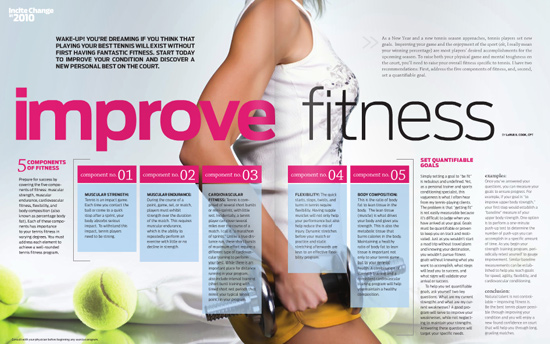Improve Fitness
WAKE-UP! YOU’RE DREAMING IF YOU THINK THAT PLAYING YOUR BEST TENNIS WILL EXIST WITHOUT FIRST HAVING FANTASTIC FITNESS. START TODAY TO IMPROVE YOUR CONDITION AND DISCOVER A NEW PERSONAL BEST ON THE COURT.
by LaRue E. Cook, CPT
As the New Year and new tennis season approaches, tennis players set new goals. Improving your game and the enjoyment of the sport (ok, I really mean your winning percentage) are most players’ desired accomplishments in the upcoming season. To raise both your physical game and your mental toughness on the court, you’ll need to raise your overall fitness that is specific to tennis. I have two recommendations: First, address the five components of fitness; second, set a quantifiable goal.
5 Components of Fitness
Prepare for success by covering the bases of fitness, which is comprised of five components: muscular strength, muscular endurance, cardiovascular fitness, flexibility, and body composition (also known as percentage body fat). Each of these components has importance to your tennis fitness in varying degrees. You must address each element to achieve a well-rounded tennis fitness program.
Component No 1 MUSCULAR STRENGTH:
Tennis is an impact game. Each time you contact the ball or come to a quick stop after a sprint, your body absorbs serious impact. To withstand this impact, tennis players need to be strong.
Component No 2 MUSCULAR ENDURANCE:
During the course of a point, game, set, or match players must exhibit strength over the duration of the match. This requires muscular endurance which is the ability to repeatedly perform an exercise with little or no decline in strength.
Component 3 CARDIOVASCULAR FITNESS:
Tennis is comprised of several short bursts or mini-sprints, with little rest. Incidentally, a tennis player can cover several miles over the course of the match. I call it “a marathon of sprints.” Unlike a true distance run, these short bursts of maximum effort require a different type of cardiovascular training to perform your best. While there is an important place for distance running in your program, also include interval training (short burst training with timed short rest periods that mimic your typical tennis point) in your program.
Component 4 FLEXIBILITY:
The quick starts, stops, twists, and turns in tennis require flexibility. Having supple muscles will not only help your performance, but help reduce the risk of injury. Dynamic stretches before your match or practice, and static stretching afterwards are key to an effective flexibility program.
Component No 5: BODY COMPOSITION: This is the ratio of body fat to lean tissue in the body. The lean tissue (muscle) is what drives your body and gives you strength. This is also the metabolic tissue that burns calories in the body. Maintaining a healthy ratio of body fat to lean tissue is important not only to your tennis game but to your general health. A combination of strength training and a consistent cardiovascular training program will help you maintain a healthy composition.
SET QUANTIFIABLE GOALS
Setting a goal to “be fit” is nebulous and undefined. Yet, as a personal trainer and sports conditioning specialist, this vagueness is what I often hear from my tennis playing clients. The problem is that “getting fit” is not easily measurable, because it’s difficult to judge when you have arrived at your goal. Goals must be quantifiable or proven to keep you on track and motivated. Just as you wouldn’t start a road trip without travel plans and knowing your destination, you wouldn’t pursue fitness goals without knowing what you want to accomplish, what steps will lead you to success, and what signs will validate your arrival or success.
To help you set quantifiable goals, ask yourself two key questions: What are my current strengths and what are my weaknesses? A good program will serve to improve your weaknesses, while not neglecting to maintain your strengths. Answering these questions will target your specific needs.
Examples:
Once you’ve answered your questions, you can measure your goals to ensure progress. For example, if your goal is “to improve upper body strength,” your first step would establish a “baseline” measure of your upper body strength. One option: perform a one-minute push-up test to determine the number of push-ups in which you can accomplish. As you begin your strength training program, periodically retest yourself to gauge improvement. Similar baseline measurements can be established to help you reach goals for speed, agility, flexibility, and cardiovascular conditioning.
Conclusion:
Natural talent is not controllable – improving fitness is. Be the best tennis player possible through improving your condition and you will enjoy a new found confidence on court that will help you through long, grueling matches.
Incite Change in 2010 Continued...

